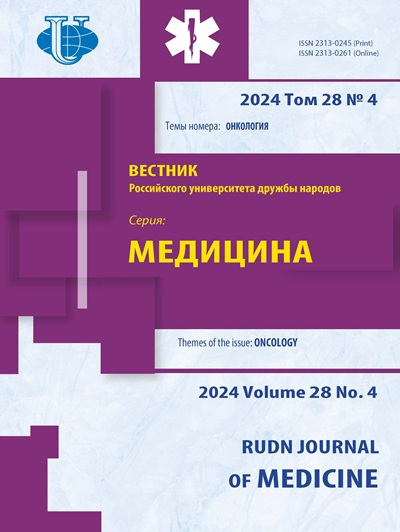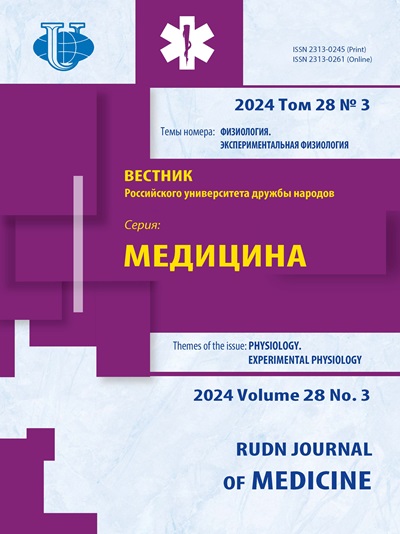Особенности пролиферации и апоптоза овариальных фолликулов после локального облучения электронами и введения плазмы, обогащенной тромбоцитами
- Авторы: Демяшкин Г.1,2, Муртазалиева З.1, Пугачева Е.1, Вадюхин М.А.3, Бимурзаева М.3, Милованова А.3, Деньгина Т.3
-
Учреждения:
- Российский университет дружбы народов имени Патриса Лумумбы
- Национальный медицинский исследовательский центр радиологии
- Первый Московский государственный университет им. И.М. Сеченова
- Выпуск: Том 28, № 3 (2024): ФИЗИОЛОГИЯ. ЭКСПЕРИМЕНТАЛЬНАЯ ФИЗИОЛОГИЯ
- Страницы: 311-318
- Раздел: ФИЗИОЛОГИЯ. ЭКСПЕРИМЕНТАЛЬНАЯ ФИЗИОЛОГИЯ
- URL: https://journals.rudn.ru/medicine/article/view/36985
- DOI: https://doi.org/10.22363/2313-0245-2024-28-3-36985
- EDN: https://elibrary.ru/FZDMOW
Цитировать
Полный текст
Аннотация
Актуальность. Яичник является одним из наиболее радиочувствительных органов. Воздействие ионизирующего излучения может приводить к снижению репродуктивной функции вплоть до бесплодия. Одним из многообещающих регенеративных субстратов является плазма, обогащенная тромбоцитами (PRP), которая содержит в своем составе большое количество биологически активных веществ. Необходимо проведение исследований в этом направлении с целью определения дозозависимых эффектов облучения электронами на пролиферацию и апоптоз ооцитов и клеток гранулезы, а также оценки рисков развития радиационно‑ индуцированной овариальной недостаточности. Важное значение имеет разработка методов профилактики острых постлучевых осложнений, в рамках которой возможно применение плазмы, обогащенной тромбоцитами. Цель: иммуногистохимическая оценка пролиферации и апоптоза структур яичника после введения плазмы, обогащенной тромбоцитами, в модели радиационно‑ индуцированной овариальной недостаточности. Материалы и методы. Крысы породы Вистар (n=40) были поделены на группы: I — контрольная (n=10); II (n=10) — облучение электронами; III (n=10) — введение плазмы, обогащенной тромбоцитами, до облучения электронами; IV (n=10) — введение плазмы, обогащенной тромбоцитами. Проводили морфологическую оценку и иммуногистохимическое исследование яичников с антителами к Ki‑67 и каспазе‑3. Результаты и обсуждение. В фолликулах яичников II‑ой группы отмечали резкое снижение доли Ki‑67‑позитивных гранулезных клеток, однако в тека‑клетках уровень экспрессии этого маркера превышал контрольные значения. В то же время, количество каспаза‑3‑окрашенных клеток резко возрастало, преимущественно за счет гранулезных клеток. Описанные иммуногистохимические паттерны были менее выражены в группе предлучевого введения плазмы, обогащенной тромбоцитами. Выводы. Компоненты плазмы, обогащенной тромбоцитами, обладают радиопротективным свойством, поддерживая пролиферативно‑а поптотический баланс фолликулярных клеток и снижая глубину и диапазон лучевого поражения яичника при воздействии фракционного локального облучения электронами в суммарной дозе 20 Гр, подтвержденной уровнями экспрессии Ki‑67 и каспазы‑3.
Ключевые слова
Об авторах
Григорий Демяшкин
Российский университет дружбы народов имени Патриса Лумумбы; Национальный медицинский исследовательский центр радиологии
Email: dr.dga@mail.ru
ORCID iD: 0000-0001-8447-2600
SPIN-код: 5157-0177
док. мед. наук, ведущий научный сотрудник Научно-образовательного ресурсного центра «Инновационные технологии иммунофенотипирования, цифрового пространственного профилирования и ультраструктурного анализа» Российского университета дружбы народов имени Патриса Лумумбы, заведующий отделом патоморфологии Национального медицинского исследовательского центра радиологии Минздрава РФ
Россия, 117198, Россия, Москва, ул. Миклухо-Маклая, 6; 125284, Россия, Москва, 2-й Боткинский проезд, д. 3Заира Муртазалиева
Российский университет дружбы народов имени Патриса Лумумбы
Email: ZARIA.ALIEVA.90@BK.RU
ORCID iD: 0009-0000-2361-7618
SPIN-код: 2847-2984
аспирант ИТМиБ Сеченовского университета
Россия, г. Москва, Российская ФедерацияЕкатерина Пугачева
Российский университет дружбы народов имени Патриса Лумумбы
Email: rouzella@mail.ru
ORCID iD: 0009-0009-2268-3838
SPIN-код: 5784-9384
аспирант ИТМиБ Сеченовского университета
Россия, г. Москва, Российская ФедерацияМатвей Анатольевич Вадюхин
Первый Московский государственный университет им. И.М. Сеченова
Email: vma20@mail.ru
ORCID iD: 0000-0002-6235-1020
SPIN-код: 9485-7722
студент Института клинической медицины им. Н.В. Склифосовского
Россия, 119991, Россия, Москва, ул. Трубецкая, 8/2Макка Бимурзаева
Первый Московский государственный университет им. И.М. Сеченова
Email: bimakka@mail.ru
ORCID iD: 0000-0002-3065-0755
SPIN-код: 2637-5894
студент Института клинической медицины им. Н.В. Склифосовского
119991, Россия, Москва, ул. Трубецкая, 8/2Айгуль Милованова
Первый Московский государственный университет им. И.М. Сеченова
Email: Ovezberdiyevaayka@gmail.com
ORCID iD: 0009-0007-9681-5704
SPIN-код: 9590-8578
студент Института клинической медицины им. Н.В. Склифосовского
Россия, 119991, Россия, Москва, ул. Трубецкая, 8/2Тамара Деньгина
Первый Московский государственный университет им. И.М. Сеченова
Автор, ответственный за переписку.
Email: larobrine@mail.ru
ORCID iD: 0009-0002-0651-9711
SPIN-код: 5877-3869
студент Института клинической медицины им. Н.В. Склифосовского
119991, Россия, Москва, ул. Трубецкая, 8/2Список литературы
- Ahmed Y, Khan AMH, Rao UJ, Shaukat F, Jamil A, Hasan SM et al. Fertility preservation is an imperative goal in the clinical practice of radiation oncology: a narrative review. Ecancermedicalscience. 2022;16:1461. doi: 10.3332/ecancer.2022.1461
- Terenziani M, Piva L, Meazza C. Oophoropexy: a relevant role in preservation of ovarian function after pelvic irradiation. Fertility and Sterility. 2009;91(3):935.e15–935.e16. doi: 10.1016/j.fertnstert.2008.09.029
- Kaur S, Kurokawa M. Regulation of Oocyte Apoptosis: A View from Gene Knockout Mice. International Journal of Molecular Sciences. 2023;24(2):1345. doi: 10.3390/ijms24021345
- Zhang W, Huang L, Kong C, Liu J, Luo L, Huang H. Apoptosis of rat ovarian granulosa cells by 2,5‑hexanedione in vitro and its relevant gene expression. Journal of Applied Toxicology. 2013;33(7):661–669. doi: 10.1002/jat.2714
- Dawood AS, Salem HA. Current clinical applications of platelet-rich plasma in various gynecological disorders: An appraisal of theory and practice. Clinical and Experimental Reproductive Medicine. 2018;45(2):67–74. doi: 10.5653/cerm.2018.45.2.67
- Sfakianoudis K, Simopoulou M, Grigoriadis S, Pantou A, Tsioulou P, Maziotis E et al. Reactivating Ovarian Function through Autologous Platelet-Rich Plasma Intraovarian Infusion: Pilot Data on Premature Ovarian Insufficiency, Perimenopausal, Menopausal, and Poor Responder Women. Journal of Clinical Medicine. 2020;9(6):1809. doi: 10.3390/jcm9061809
- Xu P, Wu Y, Zhou L. Platelet-rich plasma accelerates skin wound healing by promoting re-epithelialization. Burns Trauma. 2020;8: tkaa028. doi: 10.1093/burnst/tkaa028
- Demyashkin GA, Vadyukhin MA, Shekin VI. The Influence of Platelet-Derived Growth Factors on the Proliferation of Germinal Epithelium After Local Irradiation with Electrons. Journal of Reproduction and Infertility. 2023;24(2):94–100. doi: 10.18502/jri.v24i2.12494
- Ozcan P, Takmaz T, Tok OE, Islek S, Yigit EN, Ficicioglu C. The protective effect of platelet-rich plasma administrated on ovarian function in female rats with Cy-induced ovarian damage. Journal of Assistant Reproduction and Genetics. 2020;37(4):865–873. doi: 10.1007/s10815-020-01689-7
- Kudryavtsev GY, Kudryavtseva LV, Mikhaleva LM, Kudryavtseva YY, Solovyeva NA, Osipov VA, et al. Immunohistochemical study of P53 protein expression in different prostate cancer Gleason grading groups. RUDN Journal of Medicine. 2020;24(2):145–155. doi: 10.22363/2313-0245-2020-24-2-145-155
- Kudryavtsev GY, Kudryavtseva LV, Mikhaleva LM, Babichenko II. Immunohistochemical Study of Tumor Cells Proliferative Activity at Different Graduations of Prostate Cancer. RUDN Journal of Medicine. 2019;23(4):364–372. doi: 10.22363/2313-0245-2019-23-4-364-372
- Reisz JA, Bansal N, Qian J, Zhao W, Furdui CM. Effects of ionizing radiation on biological molecules — mechanisms of damage and emerging methods of detection. Antioxidants Redox Signals. 2014;21(2):260–292. doi: 10.1089/ars.2013.5489
- An J, Du X, Zhang F, Chen J, Dai J, Huang M et al. Effect of radiotherapy on ovarian function in patients with cervical cancer undergoing radical surgery. Chinese Journal of Radiation Oncology. 2019;28(10):753–756.
- Almeida CP, Ferreira MCF, Silveira CO, Campos JR, Borges IT, Baeta PG et al. Clinical correlation of apoptosis in human granulosa cells-A review. Cell Biology International. 2018;42(10):1276–1281. doi: 10.1002/cbin.11036
- Seckin S, Ramadan H, Mouanness M, Kohansieh M, Merhi Z. Ovarian response to intraovarian platelet-rich plasma (PRP) administration: hypotheses and potential mechanisms of action. Journal of Assistant Reproduction and Genetics. 2022;39(1):37–61. doi: 10.1007/s10815-021-02385-w
- Bos-Mikich A, de Oliveira R, Frantz N. Platelet-rich plasma therapy and reproductive medicine. Journal of Assistant Reproduction and Genetics. 2018;35(5):753–756. doi: 10.1007/s10815-018-1159-8
- Sills ES, Wood SH. Autologous activated platelet-rich plasma injection into adult human ovary tissue: molecular mechanism, analysis, and discussion of reproductive response. Bioscience Rep. 2019;39(6): BSR20190805. doi: 10.1042/BSR20190805
Дополнительные файлы




















